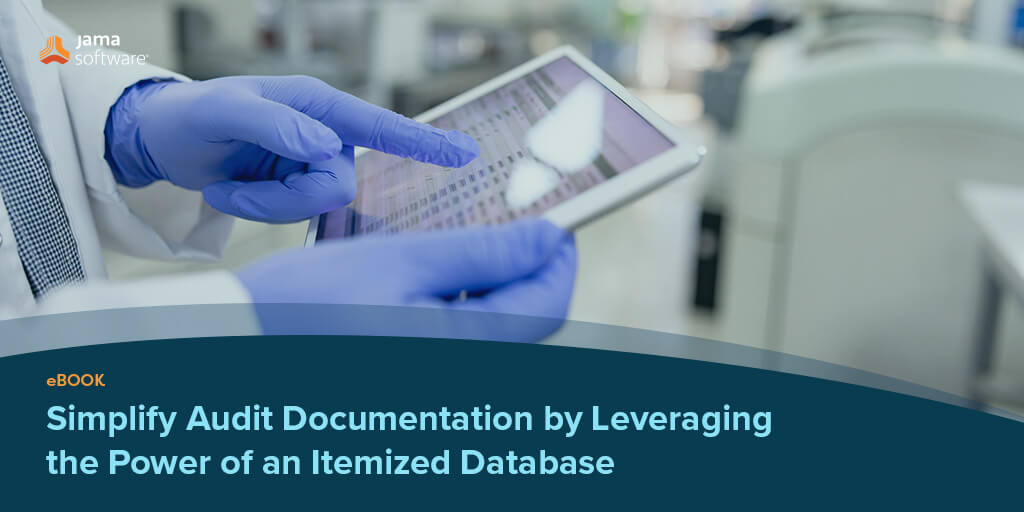
In this blog, we recap a section of our recent eBook, “Simplify Audit Documentation by Leveraging the Power of an Itemized Database” – Click HERE to read the whole thing.
Simplify Audit Documentation by Leveraging the Power of an Itemized Database
How to enhance efficiency, auditability, and stay ahead of the competition with Jama Connect® for Medical Device Development
In the current landscape of medical device and life sciences development — in addition to facing relentless pressures to innovate, remain competitive, and release quality products — medical device developers also must comply with rigorous regulations and standards for their products to be marketed, distributed, and sold in regulated markets like the United States and the European Union.
However, reliance on traditional documents or legacy document-driven systems like Cognition Cockpit and Polarion poses challenges for professionals, particularly those in roles such as quality assurance. This eBook delves into the transition from document-centric workflows to itemized databases, focusing on Jama Connect® as a solution to enhance efficiency and auditability in product development processes.
RELATED: Jama Connect® for Medical Device & Life Sciences Development Datasheet
The Challenge of Document-Centric Workflows
Traditional product development processes for medical device companies revolve around document-centric workflows. This section highlights the inherent limitations and complexities
associated with managing requirements, traceability, and change control solely through documents.
Challenges include:
- Manual traceability matrices often lead to a time-consuming and error-prone process, making it challenging to maintain accurate and up-to-date links between requirements, design elements, and test cases, which are critical for regulatory compliance and product quality.
- Version control issues can result in confusion, inconsistencies, and potential compliance risks, as stakeholders struggle to identify the most current documentation amidst multiple iterations, revisions, and parallel development efforts.
- Difficulties working in an Agile workflow can hinder traceability and documentation, as the rapid pace of iterations and evolving requirements make it challenging to maintain clear and auditable links between user stories, tasks, and regulatory documentation, impacting the ability to demonstrate compliance and validation.
- The absence of a single source of truth contributes to inefficiencies, as disparate document repositories result in data silos, inconsistent information, and difficulty in
reconciling different versions of documentation, leading to confusion and potential errors in audits or reviews. - Slow quality management processes can delay the verification and validation of documentation, impacting the timely detection and resolution of compliance issues, and the ability to demonstrate adherence to regulatory standards, potentially delaying product approvals and market entry.
- The risk of errors escalating during iterative design phases grows as manual documentation processes and fragmented tools make it difficult to track and manage changes, increasing the likelihood of overlooked requirements, design inconsistencies, and compliance gaps that can surface during regulatory assessments and audits.
RELATED: Traceable Agile™ – Speed AND Quality Are Possible for Software Factories in Safety-critical Industries
The Value Proposition of an Itemized Database
Central to this transition is understanding the inherent value of itemized databases like Jama Connect. This section explores the tangible benefits, including real-time traceability, proactive change management, and improved product quality.
By embracing itemized databases, organizations can:
- Accelerate Product Development Cycles: By accelerating product development cycles, organizations can increase their market competitiveness and improve their ability to meet customer demands, while minimizing the risk of delays or missed opportunities caused by manual documentation processes.
- Maintain Proactive Traceability: By maintaining proactive traceability, organizations can demonstrate compliance with regulatory requirements, ensuring transparency and accountability throughout the development process, while enabling faster detection and resolution of issues before they escalate.
- Gain Visibility into Progress and Coverage: By gaining visibility into progress and coverage, organizations can identify gaps and redundancies in their documentation, prioritize requirements, and allocate resources effectively, improving overall product quality, and reducing the risk of compliance issues.
- Proactively Manage Risks: By proactively managing risks, organizations can reduce the likelihood of errors and minimize the potential impact of issues, ensuring patient safety and reducing the risk of product recalls, legal liability, or damage to reputation.
- Link Suspect Items and Manage Change: By linking suspect items and effectively managing change, organizations can streamline the change management process, minimizing the impact of revisions on other items, and ensuring that each change is properly reviewed and validated before implementation.
- Maintain an Agile Workflow: By easily maintaining an Agile workflow, organizations can support their development teams, empowering them to collaborate and innovate effectively, while ensuring that their processes remain compliant and traceable throughout the development lifecycle.
- Enhance Documentation: By enhancing compliance documentation, organizations can improve their ability to adhere to regulatory requirements and expectations, minimize the risk of non-compliance, and demonstrate their commitment to patient safety and quality outcomes.
- Reuse Requirements: By reusing requirements and enabling release management, organizations can optimize their resources, reduce duplicative efforts, and improve their ability to deliver products that meet customer needs and expectations.
- Automate Version Control: By automating version control, organizations can minimize the risk of errors caused by manual processes, streamline the review and approval of documentation, and improve their ability to manage multiple iterations and revisions while maintaining an accurate audit trail.
CLICK HERE TO READ THIS EBOOK IN ITS ENTIRETY:
Simplify Audit Documentation by Leveraging the Power of an Itemized Database
- Construction’s Next Leap: AI as a Strategic Partner - June 26, 2025
- Strategies for Addressing More Complex Custom Chip Design - May 1, 2025
- Synopsys Bold Prediction: 50% of New HPC Chip Designs Will Be Multi-Die in 2025 - March 27, 2025

